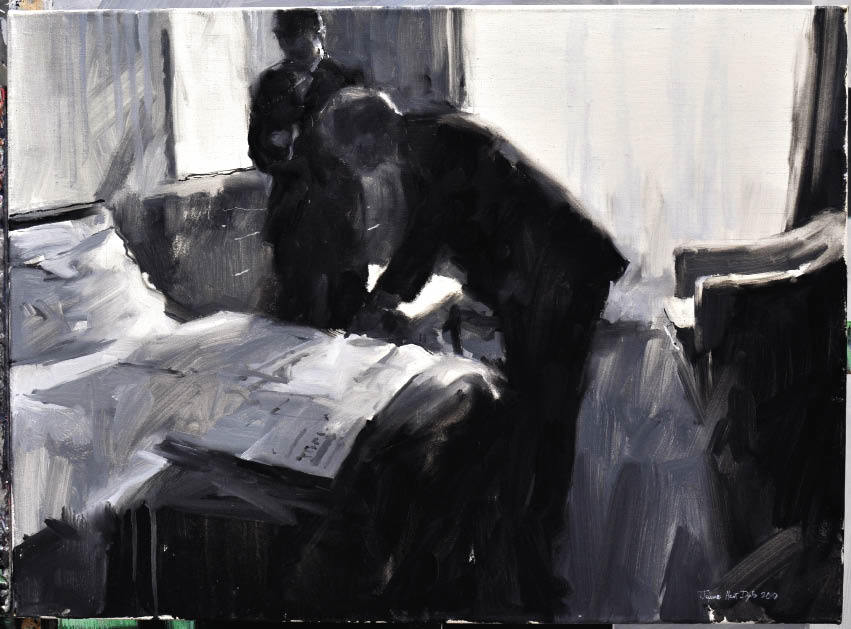There’s nothing safe or cosy — and, indeed, there shouldn’t be anything safe or cosy —about being an artist.
There’s nothing safe or cosy — and, indeed, there shouldn’t be anything safe or cosy —about being an artist. Being an artist means living on the edge, going outside your comfort zone, being challenged.
Artists put that challenge into practice in all sorts of different ways; and for me it’s meant seeking out challenge — and adventure — in a very focused way. I call what I do ‘extreme art’: I’ve deliberately set myself a series of tasks that have taken me into challenging and even dangerous situations, so I can attempt to capture on canvas not just how a situation or place looks, but also how it really feels, from the inside.
My quest for extreme art has taken me to Afghanistan and Iraq with British troops; it’s taken me on treks into remote areas of the Himalayas; and most recently it took me inside one of Britain’s most secretive organisations, MI6, where I spent a year living alongside spies in order to experience, and to paint, their world.
I was recruited into MI6 in exactly the same way that an agent might be recruited — there was a phone call from a third party, then a meeting, then more meetings inside the organisation’s HQ in Vauxhall. Would I take on the challenge of living a secret life — because I couldn’t tell anyone what I was doing — and paint its reality from the inside?
I would, and I did. The past 12 months have been extraordinary and bizarre and fascinating; I was able to see the work of MI6 at close quarters, to talk to officers and agents, and to understand what assignments and information drops and tip-offs could look like, on the ground. And I was able to paint those situations, and to try — through my work — to convey not just what it looks like but also how it feels to be a spy. And how it feels is that you’re often lonely, and you tend to feel unsettled in even the most ordinary of situations. Because that’s what spying is about: extraordinary things happen in the most mundane of settings. The images I’ve produced show people waiting and waiting often for long hours and in less than salubrious surroundings. James Bond it definitely isn’t, most of the time.
Seeking adventure as an artist has a long history: in past centuries, many mountaineers were artists who needed to scale the heights in order to paint at the top — Edward Whymper is an example. My introduction to this extreme art was through the Prince of Wales. He got to know my work when I was a student at the Royal College of Art, and in 1998 invited me to be his official artist on a tour he was making to the Himalayas. Of course, being part of the royal entourage and painting the places we visited was an amazing experience in itself: but the crucial moment for me was when we flew past Mount Everest. I looked out of the plane window and thought: I’ve got to come back here to paint these scenes.
I did go back, and I stayed about three months; and then I returned a second time and trekked deep into a remote valley in the Humla region of Nepal, a place few tourists ever visit. Being among such awesome scenery, and in genuinely dangerous and cut-off places, gave my work a whole new edge — or at least, that’s what I hope. It wasn’t just about recording what the landscape looked like, it was also about trying to commit to the canvas the feeling of being vulnerable, of being exposed.
That’s how it was, too, in Afghanistan and Iraq, where I travelled with the Grenadier Guards, embedded among them, in 2006 and 2007. As with MI6, I was one of them — I heard the gunfire, smelt the sweat, felt the fear. Sometimes the work I was doing became object-art in itself, because the paper itself was scarred by the reality of war. One sketch, for example, has a large boot-mark on it where a squaddie helpfully stamped on it when a gust of wind threatened to blow it away.
So what’s the next adventure? I’m not sure yet. MI6 will be a hard act to follow; one of the things that struck me about working there, though, was the idea of drama in the midst of everyday life. Maybe my next adventure will be a domestic one. But whatever it is, I’ll be up for it.
As told to Joanna Moorhead





Comments